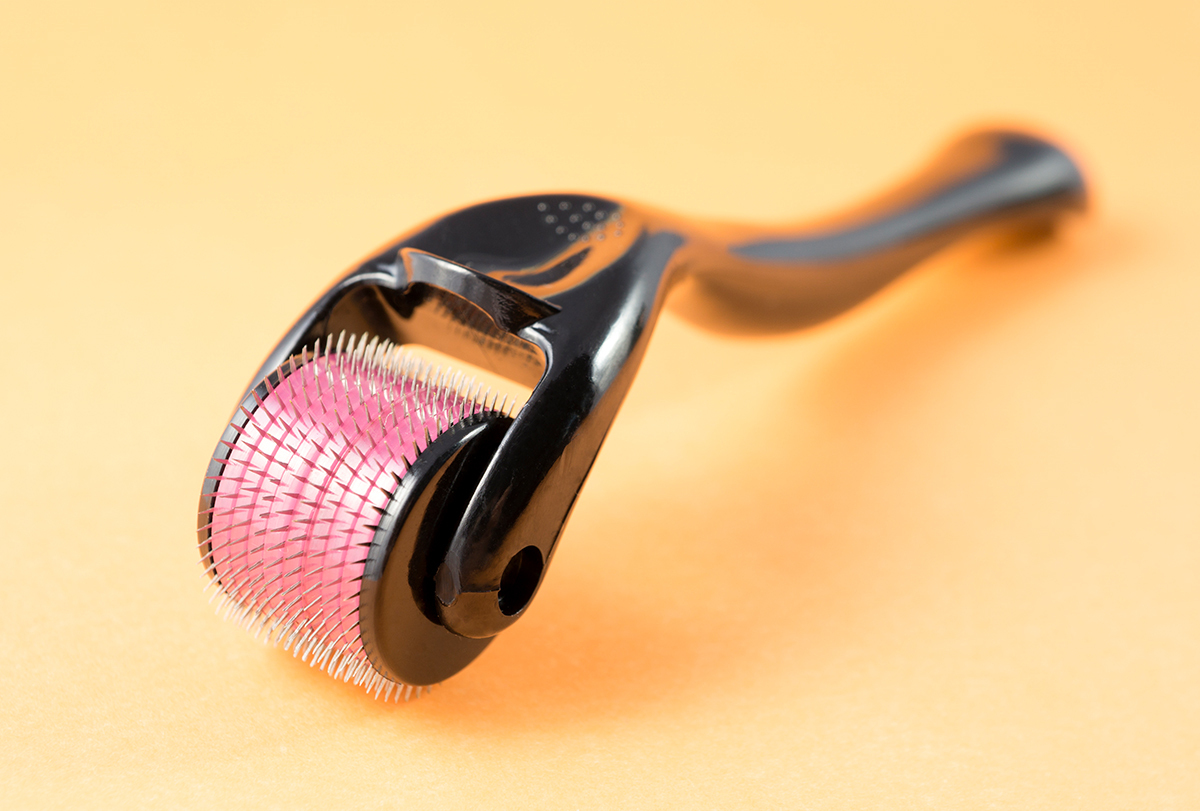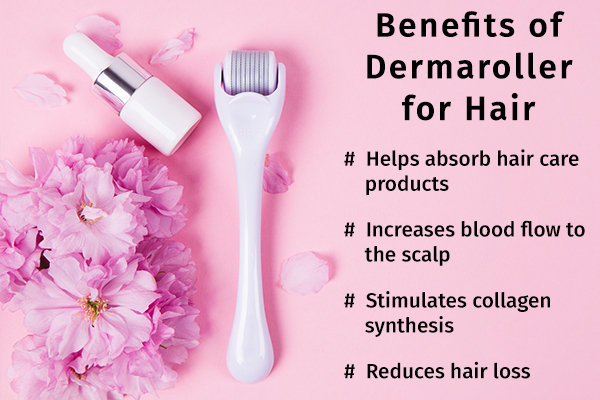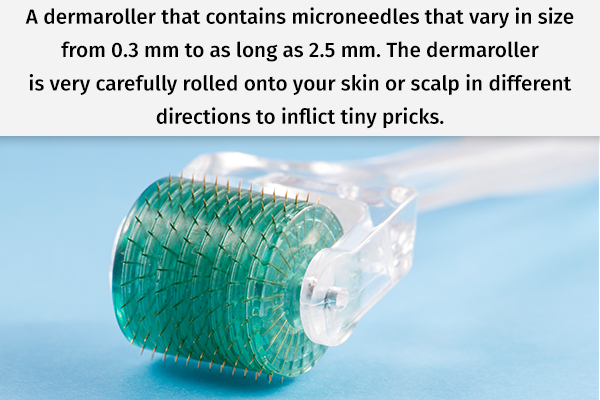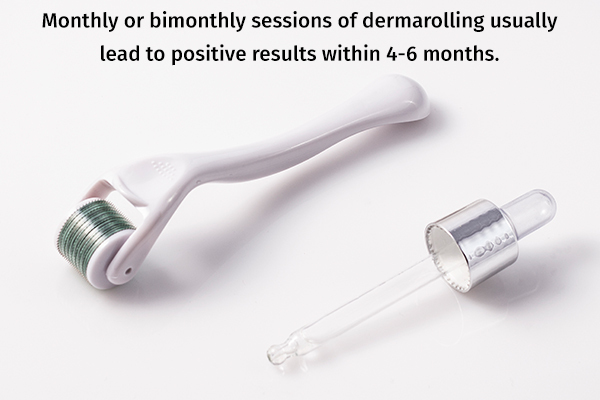In this article:
Dermarolling is a relatively new procedure that is making waves in the beauty industry.

A lot has to be discussed about dermarolling, but the first thing you should know is not to try it at home. Dermatologists strictly advise against the use of at-home dermarollers as they can injure the skin and lead to dermal infections.
What Is Dermarolling/Microneedling for Hair?
Microneedling or dermarolling is a cosmetic procedure in which a device known as a “dermaroller” is carefully rolled over your skin by a dermatologist or a skin care professional. (1)(2)
The dermaroller contains very tiny needles that puncture the skin. This initiates the skin’s repair mechanism to start collagen production and rejuvenates the skin cells. (3)(4)
The process works pretty much the same way on the scalp. Tiny pores caused by the microneedles on the scalp stimulate collagen synthesis and rejuvenate skin health. (5)
The microneedles used by doctors are sterile; they can be made of metal, glass, or polymers and are usually coated with a titanium alloy. The needles are sometimes hollow and used to inject a liquid medication or nutrient formulation into the skin.
Dermaroller Benefits for Hair

The potential benefits of using dermarollers on your scalp are:
- Helps absorb hair care products: Dermarolling creates tiny pricks on the scalp surface, increasing the penetration of hair serums, tonics, or oils into the scalp.
- Increases blood flow to the scalp: The constant rolling movements not only provide a soothing sensation but also massage the scalp, increasing blood flow and thus nourishment to the scalp, improving hair growth.
- Stimulates collagen synthesis: Dermarolling incites stem cell synthesis and collagen production in the scalp.
- Reduces hair loss: All of the aforementioned effects contribute to a significantly reduced rate of hair fall in people suffering from hair loss.
Does Dermarolling/Microneedling for Hair Actually Works?
Dermarolling for hair growth is a relatively new procedure but has proven to be effective in patients.
There is sufficient evidence that microneedling stimulates collagen and stem cell synthesis, thus enhancing hair growth in people suffering from different types of hair loss. (6)
How Is Dermarolling Done?

To briefly explain dermarolling, a dermaroller that contains microneedles that vary in size from 0.3 mm to as long as 2.5 mm is used. The dermaroller is very carefully rolled onto your skin or scalp in different directions to inflict tiny pricks.
Dermarolling at Home Versus With an Expert
Nowadays, several at-home dermarollers are widely available. However, most doctors advise against the use of DIY dermarolling devices as they are not as effective as professional devices and can also cause skin injuries and infections.
The microneedles used by doctors and certified professionals are sterile and penetrate the skin deeper, whereas at-home dermarollers are difficult to sanitize and maintain properly.
Regulatory Concerns in the Use of Dermarollers
Dermarollers, when used by certified dermatologists, are classified as low-risk devices by the FDA.
Are All Microneedling Products Considered Medical Devices That Are Regulated by the FDA?
Although the US FDA has strict rules over medical microneedling products and they are not to be sold over the counter, not all microneedling devices come under this category.
Medical microneedling devices are pens and motor devices that can puncture the skin and may cause damage if used improperly. However, exfoliating products that have microscopic needles and barely prick the skin’s surface are generally not regulated.
Scalp Rollers

The dermarollers used to treat hair loss are known as scalp rollers. They contain titanium-coated microneedles that penetrate the scalp’s surface and initiate stem cell production to increase hair growth.
Microneedling is highly effective for people suffering from androgenic alopecia. (7) Research suggests that men who use minoxidil and scalp rollers have potentially higher hair growth than men who use minoxidil alone. (8)(9)
Another study conducted recently concluded that the use of scalp rollers with minoxidil increased hair growth by four times compared to treatment with minoxidil alone. Combining microneedling with platelet-rich plasma treatment (PRP therapy) in women has also been shown to increase hair growth. (10)(11)
What Are the Risks Associated With Dermarolling?
Dermarolling is a relatively safe procedure when performed by a dermatologist. However, it can lead to skin damage or infections when not done properly.
Skin damage associated with repeated or improper dermarolling usually causes bleeding, bruises, or discoloration. When it comes to dermarolling for hair, pressing the roller too deep can damage the hair roots and cause hair fall.
Always make sure to use a sterile dermaroller to avoid skin or scalp infections. (12)
Most-Asked Questions About Dermarolling
What size of dermaroller is recommended?
The size of your dermaroller is determined by the doctor based on the thickness of the skin and indications for which it’s done.
When will I see improvements in hair growth with dermarolling/microneedling?

Monthly or bimonthly sessions of dermarolling usually lead to positive results within 4–6 months.
Can I shampoo after getting dermarolling?
Yes. Most doctors advise washing your scalp with a mild shampoo the next day after a dermarolling session.
Final Word
Dermarollers have been widely used for skin care for years. However, the use of dermarollers on the scalp for hair growth is a relatively new practice but is turning into a popular and promising treatment. It is affordable and inflicts minimal pain while providing desirable results.
- Was this article helpful?
- YES, THANKS!NOT REALLY


